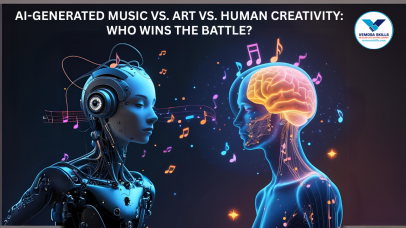AI in Agriculture in 2025: Transforming Indian Farms for a Sustainable Future
Farming in India is now changing rapidly. Where earlier farming was done in the old way, now the same work is being done with wisdom and new techniques.

There was a time when people proudly chose their career paths in creative fields like music, painting, design, and writing. Just because everyone believed that creativity came from human emotion, experience, and soul. It was the only thing machines could never copy. Creative work was personal, emotional, and deeply human.
But as it turns out... we were wrong. And you know why? Let’s discuss it below.
AI and the Creative Takeover
The one thing I must say is that the creative space is no longer just for humans. People in creative professions, who once thought that nobody could replace their unique art or talent, are now feeling the fear. That’s because AI is advancing at a crazy speed. And the craziest part? It’s not just doing the job; in some areas, it's doing it better than humans.
In 2024, we saw a revolution in AI-generated content. At first, we only thought that AI could replace content writers only, but we were wrong. It is now generating music to paintings to mind-blowing digital arts, AI tools have shown us that they’re not just assistants anymore - they’re creators. And the wildest part? They can generate a complete song or a piece of digital art in seconds. Not minutes, not hours - seconds.
Meanwhile, human artists and musicians often take days - or even weeks - to produce something polished. So yeah, the creative field, which was once thought to be the last frontier for AI, is now up for grabs.
But before we jump into who's winning or losing, let’s take a closer look at what these AIs can actually do—and how they’re changing the game.
AI Music Generation Tools That Took Over in 2024
AI-generated music is no longer just futuristic talk. It’s real, and it’s good. Let’s look at some of the major players that emerged or levelled up in 2024.
1. Suno AI
Launched in December 2023, Suno AI quickly became one of the most impressive tools out there. By November 2024, it had already reached its V4 model, and the results are crazy good. Suno creates complete songs—including vocals and instrumentals—based solely on a simple text prompt. That’s right, all you need to do is describe the vibe or theme, and Suno composes an entire track that sounds incredibly real.
The tool is integrated into Microsoft Copilot and even offers features like “remastering” older compositions. You can go from idea to full song in less than a minute.
2. Udio
Launched in April 2024, Udio gives creators the ability to generate vocal tracks with instrumentation based on text prompts. It’s genre-flexible and comes packed with features like audio editing, which is like Photoshop for sound.
Udio caught public attention when it was used to make the viral parody song "BBL Drizzy". And honestly, it’s just the beginning. The tool keeps improving and offering better control and output.
3. Other Noteworthy Tools
- Nvidia Fugato – A music generation model that blends AI and human-level musical understanding.
- AIVA (Artificial Intelligence Virtual Artist) – Especially popular in cinematic scoring and orchestral music.
- Amper Music – Used for creating royalty-free tracks for content creators and businesses.
These tools are reshaping the music industry, making it easier for anyone to create high-quality compositions—whether they’re a pro or a newbie.
AI Art Generation: From Prompts to Masterpieces
Now let’s shift to another creative realm: visual art. Just like music, AI-generated art is booming. Artists now have AI co-creators—or competitors—depending on how you look at it.
1. Midjourney V7
Midjourney kicked off a complete revolution in how we create and think about digital art. With the release of V7, it became one of the most powerful tools out there. All it takes is a well-crafted prompt, and Midjourney delivers insanely detailed, imaginative art that can rival—and sometimes go beyond—human artists.
Whether it's a realistic portrait, fantasy landscape, or futuristic cyberpunk design, Midjourney nails it. And the better your prompt, the better the results.
2. DALL·E 3.0
Developed by OpenAI, DALL·E 3.0 is another powerhouse in the AI art world. It can take any idea—no matter how wild—and turn it into a detailed image in seconds. Want a “robotic octopus playing the piano on Mars at sunset”? No problem. DALL·E will generate it for you in high-res glory.
It can also edit existing images and combine different styles to create unique, one-of-a-kind visuals.
3. Other Popular Art AIs
- Artbreeder – A collaborative tool for evolving and remixing art styles.
- Flux – Known for blending AI with surrealism and fine art.
- Runway ML – Great for creatives working in video and multimedia formats.
These tools are not just novelty anymore. They're being used in marketing, entertainment, design, and even galleries. AI-generated art is officially part of the mainstream.
The Big Question: Who Wins the Battle?
Okay, now to the main question: AI-generated music vs. art vs. human creativity—who wins?
The honest answer? There’s no winner. And there shouldn’t be one.
Yes, AI is doing amazing things in the creative space. And yes, it’s fast, efficient, and mind-blowingly accurate. But that doesn’t mean it’s here to defeat human creativity. Think of it more like a collaborator than a competitor.
AI doesn’t have emotions, memories, or life experiences. It doesn’t feel heartbreak or dream about freedom. Those are things only humans can do. What AI offers is speed, variation, and assistance—not soul.
So instead of fearing AI, we should accept it. Let it do the heavy lifting so we can focus on the emotional depth and storytelling that only humans can bring.
Here’s how you can look at it:
- For musicians: Use AI to generate base tracks, explore different genres, or overcome writer’s block. Then add your own touch.
- For artists: Use AI for mockups, concepts, or inspiration. Then improve it with your own style and emotion.
- For writers and creators: Use AI to brainstorm, research, or speed up the process. But let your voice and story be the star.
So... Is It the End or a New Beginning?
The rise of AI in creative fields is not the end of human creativity—it’s the start of a new era. One where technology and imagination come together to create things we couldn’t even dream of before.
Think about it like this: the camera didn’t kill painting. The computer didn’t kill handwriting. And AI won’t kill creativity. It’ll just change how we express it.
Conclusion
The landscape of creativity is evolving fast. AI-generated music, AI-generated art, and even AI writing tools are now part of our reality. But the battle isn't about who wins or who loses. It’s about how we can use these tools to enhance our creativity rather than fear it.
Human creativity is not going anywhere. It’s just getting a tech-powered upgrade.
Farming in India is now changing rapidly. Where earlier farming was done in the old way, now the same work is being done with wisdom and new techniques.
Nowadays, the world is changing very fast. Many new things and technologies are coming. One such technology is Artificial Intelligence (AI). AI means the ability of computers and machines to think and work like humans. This technology is now being used in every field, and education is also not untouched by it.
In the last 2-3 years, AI has changed so much that it has transformed every industry. It has completely changed the way of work. Every second, a new AI tool is coming and making some work easy and fast. The work that used to take many days or months earlier is now being done in just a few seconds, this is no less than a miracle.

Our free career counseling services are designed to help you navigate your professional journey with confidence. Our expert counselors provide personalized guidance, helping you explore career options, set goals, and develop strategies to achieve them.
Signup Now